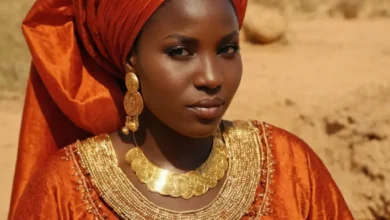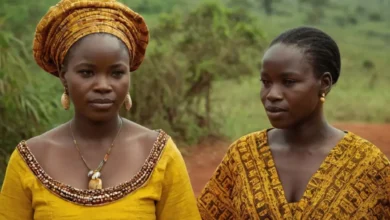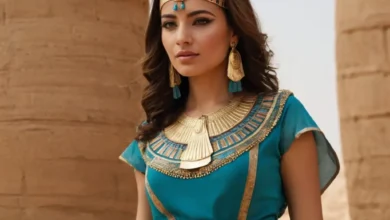Togolese Traditional Clothing
Nestled in West Africa, Togo is a country brimming with cultural richness, a tapestry woven with the threads of diverse ethnicities and traditions. One of the most striking expressions of this cultural heritage is embodied in the vibrant and intricate traditional clothing of its people. From the elaborate headwear of the Ewe to the colorful garments of the Kabyè, each garment tells a story, reflecting ancestral wisdom, social status, and spiritual beliefs.
A Symphony of Colors and Patterns: The Essence of Togolese Traditional Clothing
Togolese traditional clothing is not merely attire; it is an art form, a living testament to the creativity and ingenuity of its people. The use of vibrant colors, intricate patterns, and unique embellishments sets Togolese fashion apart. Each ethnic group boasts its distinctive style, creating a diverse and captivating visual landscape across the country.
Ewe: The Symbol of Grace and Elegance
The Ewe people, the largest ethnic group in Togo, are renowned for their elegant and sophisticated clothing. The women’s attire is characterized by their intricate, brightly colored kente cloth, a woven fabric that is often adorned with symbolic patterns representing ancestral wisdom, social status, and spirituality. This cloth, meticulously crafted by hand, is often worn as a wraparound skirt (kaba), while the upper body is adorned with a blouse or a shawl.
Ewe men traditionally wear loose-fitting trousers (gbé) and shirts, often complemented by a headwrap or a hat. They may also wear beaded necklaces or other ornaments to signify their status and social standing. The Ewe people believe that clothing has a spiritual dimension, and their garments are often imbued with protective symbols and charms to ward off evil spirits and bring good fortune.
See also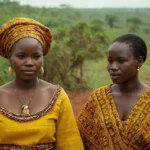 Ugandan Traditional Clothing: Barkcloth, Gomesi, and Other Cultural Attire
Ugandan Traditional Clothing: Barkcloth, Gomesi, and Other Cultural Attire
Kabyè: Celebrating Strength and Identity
The Kabyè people, known for their warrior heritage and their distinctive culture, have a unique style of clothing that reflects their strong sense of identity. Their garments are often made of cotton or leather and are decorated with intricate embroidery and beadwork. Kabyè men typically wear loincloths (bako), tunics, and elaborate headwear. The headwear, adorned with feathers and beads, is a symbol of their social status and represents their ancestral lineage.
Kabyè women wear skirts and blouses, often decorated with colorful beadwork and intricate patterns. Their clothing is frequently associated with religious ceremonies and festivals, where it plays a vital role in expressing their spiritual beliefs.
Other Ethnic Groups: A Tapestry of Diversity
Beyond the Ewe and Kabyè, Togo’s cultural landscape is enriched by numerous other ethnic groups, each with its own unique style of traditional clothing. The Tem, known for their craftsmanship, create intricate beaded necklaces and colorful woven fabrics, while the Mina are famous for their elaborate beadwork and their use of vibrant colors in their clothing.
The Kotokoli, known for their farming traditions, wear simple but practical garments made of natural fibers, reflecting their connection to the land.
See also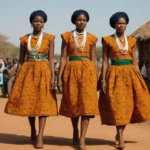 Zambian Traditional Clothing: A Blend of Tribal Traditions and Modern Influences
Zambian Traditional Clothing: A Blend of Tribal Traditions and Modern Influences
These diverse styles of clothing showcase the incredible artistic talent and cultural richness of Togo’s various ethnic groups. Each garment is a testament to the enduring traditions and the vibrant spirit of the Togolese people.
Beyond Fashion: The Profound Significance of Togolese Traditional Clothing
Togolese traditional clothing is more than just fabric and adornment; it is a living repository of cultural history, social identity, and spiritual beliefs. The garments hold profound meaning for the Togolese people, reflecting their values, beliefs, and way of life.
Symbolic Patterns: Language Beyond Words
The patterns and motifs used in Togolese traditional clothing are often imbued with symbolic meanings that extend beyond aesthetic considerations. The colors, shapes, and designs communicate stories, beliefs, and ancestral wisdom. For example, the stripes in the Ewe kente cloth can represent different clan lineages, while specific patterns on a Kabyè woman’s skirt can denote her marital status or social rank.
Celebrations and Rituals: A Tapestry of Tradition
Togolese traditional clothing plays a vital role in various celebrations and rituals, marking significant moments in the lives of individuals and communities. At weddings, elaborate garments are worn to symbolize the union of families and the transition into a new phase of life. During festivals and religious ceremonies, specific clothing styles are worn to honor deities, ancestors, and the cultural heritage of the community.
A Connection to the Past: Preserving Cultural Heritage
The wearing of traditional clothing serves as a powerful reminder of the rich cultural heritage of Togo. It connects the present generation to their ancestors and serves as a tangible symbol of their cultural identity. By keeping these traditions alive, the Togolese people ensure that their unique heritage will continue to flourish for generations to come.
Modernity Meets Tradition: A Fusion of Styles
In the contemporary world, Togolese traditional clothing is evolving as it embraces modern trends and styles. While the core elements of traditional garments are retained, contemporary designers are incorporating innovative techniques and materials, blending traditional aesthetics with modern design elements. This fusion of styles reflects the dynamic nature of Togolese culture, where tradition and modernity coexist in a harmonious embrace.
The Rise of Modern Designers
A new generation of Togolese fashion designers is emerging, taking inspiration from traditional motifs and techniques while injecting them with contemporary sensibilities. They are creating modern garments that celebrate Togolese culture while appealing to a wider audience. These designers are often showcasing their creations on international platforms, bringing Togolese fashion to the global stage and further highlighting its beauty and artistry.
Promoting Cultural Awareness
The resurgence of interest in Togolese traditional clothing is not only a reflection of fashion trends but also a growing awareness of cultural heritage. By incorporating traditional elements into their designs, contemporary designers are promoting cultural awareness and appreciation both within Togo and beyond its borders. They are helping to ensure that these traditions are not lost but rather revitalized and celebrated for generations to come.
Preserving a Cultural Legacy: Facing Challenges and Opportunities
The preservation of Togolese traditional clothing faces challenges in the modern world. The globalization of fashion and the influence of Western trends can pose threats to the continued use and appreciation of traditional styles. However, there are also opportunities to ensure that these traditions are preserved and celebrated for generations to come.
The Importance of Education and Awareness
Education plays a crucial role in preserving traditional clothing. By teaching younger generations about the significance of these garments and the cultural values they embody, we can foster appreciation and ensure that these traditions continue to be valued and passed down through the generations.
Supporting Local Artisans and Designers
Supporting local artisans and designers is essential for the survival of traditional clothing. By purchasing handcrafted garments and encouraging the use of locally sourced materials, we can contribute to the economic sustainability of these crafts and help to ensure that these traditions are passed down through generations.
Celebrating Cultural Diversity
Promoting cultural diversity through the appreciation of traditional clothing is vital. By highlighting the beauty and uniqueness of Togolese traditional fashion, we can create a more inclusive and appreciative environment for all cultures. The richness and diversity of Togolese clothing can serve as a reminder of the beauty of our world and the importance of celebrating the unique cultural expressions of different communities.
Frequently Asked Questions (FAQs)
Where can I find authentic Togolese traditional clothing?
Authentic Togolese traditional clothing can be found at local markets, craft shops, and specialized boutiques in Togo. Many online retailers also offer a range of traditional garments and accessories. If you are interested in purchasing from artisans directly, you can often find them at festivals and cultural events.
What are the different types of Togolese traditional headwear?
Togolese traditional headwear varies widely depending on the ethnic group. The Ewe people often wear colorful headwraps (kuku) or turbans, while the Kabyè men wear elaborate headwear adorned with feathers and beads, signifying their social status and ancestral lineage. The Tem and Mina people also have their own unique styles of headwear, often incorporating beads, shells, and other adornments.
How can I learn more about the symbolic meanings of Togolese traditional clothing?
There are many resources available to learn more about the symbolic meanings of Togolese traditional clothing. You can consult books, articles, and websites dedicated to Togolese culture and fashion. Museums and cultural centers in Togo often have exhibits showcasing traditional clothing and the stories behind them. Speaking with local artisans and elders can also provide valuable insights into the significance of these garments.
Togo’s traditional clothing is a vibrant tapestry of cultural expression, reflecting the rich heritage, diverse ethnicities, and spiritual beliefs of its people. The vibrant colors, intricate patterns, and unique styles of these garments tell stories of ancestral wisdom, social status, and the enduring traditions of the Togolese people. By celebrating and preserving these traditions, we can ensure that the cultural legacy of Togo continues to flourish for generations to come.
As we move forward, it is essential to recognize the challenges and opportunities associated with the preservation of Togolese traditional clothing. By promoting education and awareness, supporting local artisans and designers, and celebrating cultural diversity, we can contribute to the continued appreciation and vitality of this vital aspect of Togolese cultural heritage.

